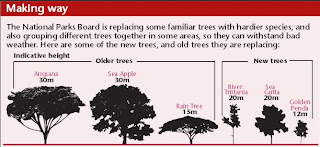To reduce risk of trees and branches falling, smaller and shorter species are planted
Hoe Pei Shan Straits Times 19 May 13;
Tall trees in some parts of Singapore are being replaced more speedily with shorter, smaller species to reduce the risk of falling branches and trees toppling over.
The National Parks Board (NParks) has over the past two years stepped up its ongoing replacement planting programme taking into account shifts in weather patterns in the region.
It said that incidents of "tree failure", defined as anything from broken branches to fallen trees, have been caused mainly by bouts of adverse weather conditions rather than maintenance issues.
So it is replacing some familiar trees with species that might be less vulnerable to mishap, and also grouping different trees together in some areas, so they can withstand bad weather.
Along Bishan Streets 11 and 14, for example, sea apple trees, a native species typically 30m tall, are being replaced by river tristanias, which grow up to 20m tall.
Other trees being replaced in selected areas include khaya, angsana and rain trees. The first two can reach 30m and are known to be especially prone to breakage. In areas where they are being replaced, smaller trees like the sea gutta, which grows to 20m, and the golden penda, which reaches 12m, will appear.
The aim is to find the right trees for the right areas, NParks streetscape director Oh Cheow Sheng told The Sunday Times.
It also considers the condition of individual trees, the potential impact of development work in an area and site conditions.
"Where verge space is more limited, we do make sure that we put in small to mid-size trees," said Mr Oh, noting that the new trees take up less space.
NParks' efforts have been welcomed by arborists and landscape architects, some of whom have called for reviews of streetside tree species after recent cases of falling branches and toppled trees that have damaged property or cost lives.
On April 27, driving instructor Jason Cheong, 25, died after a 14m rain tree fell in heavy rain along Admiralty Road West and crushed the car he was in. His student suffered minor cuts and abrasions.
Over the past decade, four people have died and 62 were injured by fallen trees and branches.
There were 122 uprooted trees from January to April this year, which NParks blamed mainly on Sumatra squalls last month.
This was a drop from 184 trees in the same period last year but more than double the 63 in 2009.
The highest number was in 2011, when 636 trees were uprooted, mainly due to microbursts - a localised, powerful and descending air draft column, which produces winds at high speeds - that occurred in Mandai and Sungei Kadut that February.
While NParks proceeds with replacing some trees, Singapore's well-known green image is in no way under threat. Mr Oh said NParks would work to keep some of the more scenic tree-lined routes even as it strikes a balance between aesthetics and risk to the public.
Aside from a one-to-one replacement of older trees, it is also carrying out clustering, where a mix of species are planted in a group along roads.
"Having clusters of different trees helps break the impact of strong winds, and more stretches of roads have been treated this way over the last year," said Mr Oh.
Along the Central Expressway, which used to be spotted with single khaya trees, there are now several clusters of mixed tree species.
Landscape architecture firm Coen Design's managing director Ann Teo said cluster planting was a way to emulate what works well in nature.
Urban greening specialist Veera Sekaran noted that modernisation has affected wind directions and forces, as well as water flow, impacting the growth and resilience of trees here.
"As trees get older, they become more susceptible to these urban stresses, and most of our roadside trees have been around for decades," said Mr Sekaran. "It is good that NParks knows it has to update its greenery strategy and replacement planting is a step in the right direction, but they need a better sense of urgency so we can see more results across Singapore."
Some tall trees being replaced
posted by
Ria Tan
at
5/19/2013 08:13:00 AM
![]()





